LED Lightning
A long time ago, people depended on natural light sources like the sun to do their day-to-day activities. They have to wind up their work before the sun sets. See! How difficult would it be? They live a life with a restricted schedule and are allowed to work only 12 hours a day. Can’t imagine. Right? Think about the impact it could have on productivity. After the invention of the LED lamp, things changed.
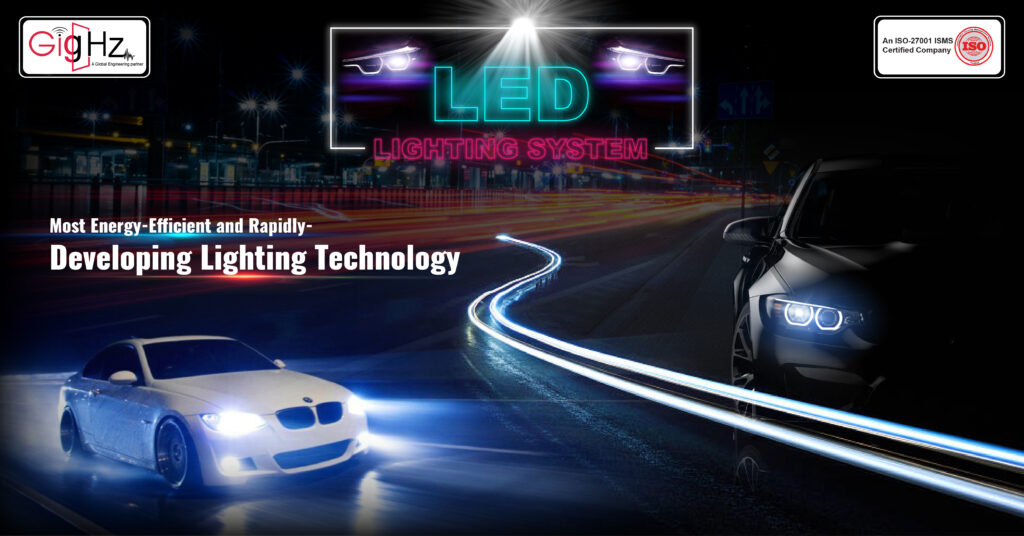

Long time ago, people totally depend on natural light sources like sun to do their day-to-day activities. They have to wind up their work before the sun sets. See! How difficult it would be? They live a life with restricted schedule and allowed to work only 12 hours a day. Can’t imagine. Right? Think about the impact it could have on productivity.
Category :
Published Date :
November 25, 2023
Category :
Published Date :
November 25, 2023
Category :
Published Date :
November 25, 2023
After the gradual innovation of lights, now the night seems to look like a day. It almost changed the life of all people and they don’t even have a feeling of working at night.
In the automotive sector, its impact is great. After the introduction of LED lighting solutions, the automotive industry hit its peak. The automotive sector is an innovative sector that brings together all the current technologies to improve the functionality of the components to provide comfort and safety to vehicle users.
Like that, it gets upgraded with an LED Lighting system.
The light-emitting diode (LED) is today’s most energy-efficient and rapidly developing as well as understanding “What is LED technology?”.
Quality and the best LED products last longer, are more durable and offer comparable or better light quality than other types of lighting.
Here is the article to describe to you all the recent trends and technologies in using LED Lighting Systems
- How Things Become Different with LEDs?
- LED Vs HID Headlamps: Which one to choose?
- Why is LED Interior Lighting so cool?
- Is Exterior LED Lighting Pleasant to the Eye?
- What are the Advantages of LED Lighting Technology?
How Things Become Different with LEDs?
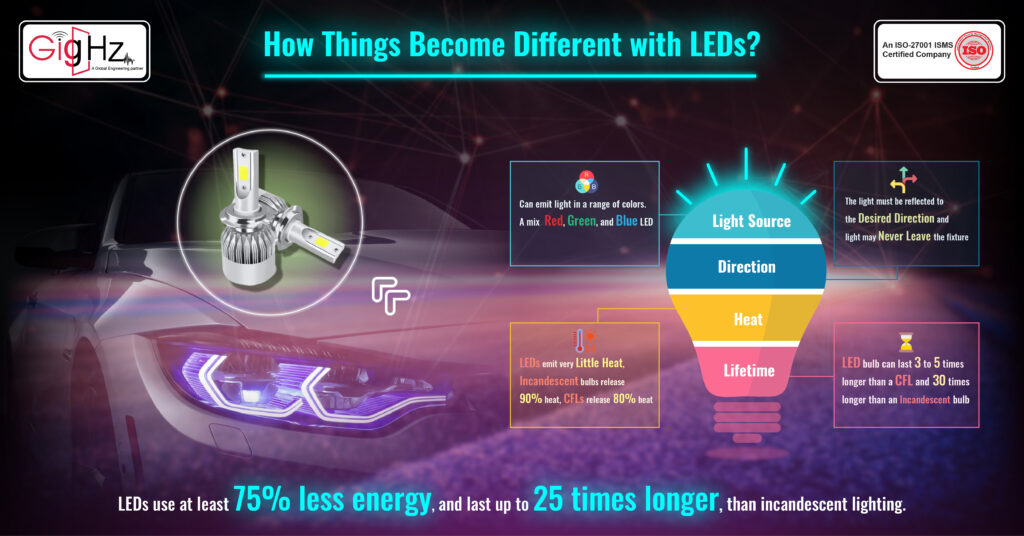
LED is a highly energy-efficient lighting technology and has the potential to fundamentally change the future of lighting everywhere.
LEDs especially use at least 75% less energy, and last up to 25 times longer, than incandescent lighting. As LEDs continue to improve in efficiency and reduce in cost where the light output levels from packaged LED devices roughly doubles every 18 months.
So, the next question arises: “What are the applications of LED?” With the low LED power consumption compared to conventional lighting, an estimated 0.2 liters of fuel per 100 km and about 4 grams lower CO2 emissions/km are the ultimate advantages of replacing incandescent lighting with LEDs in the DRL application alone.
In electric and hybrid vehicles, an 85 percent reduction in energy consumption from LED usage instead of incandescent light bulbs was the reason behind increased usage.
- Light Source: LEDs are the size of a fleck of pepper, and can emit light in a range of colors. A mix of red, green, and blue LED is sometimes used to make white light.
- Direction: LEDs emit light in a specific direction, reducing the need for reflectors and diffusers that can trap light. This feature makes LEDs more efficient for many uses such as recessed downlights and task lighting.
- Heat: LEDs emit very little heat. In comparison, incandescent bulbs release 90% of their energy as heat and CFLs release about 80% of their energy as heat.
- Lifetime: LED lighting products typically last much longer than other lighting types. A good quality LED bulb can last 3 to 5 times longer than a CFL and 30 times longer than an incandescent bulb.
LED drivers can also be designed to offer a combination of series and parallel LED control.
Devices with this capability are flexible enough to control LEDs in different lighting applications with a single driver rather than requiring different devices that increase layout work and qualification testing.
Dimming the light level as per the requirement is needed for interior lighting. However, exterior lighting also has applications requiring different brightness from the same LED.
For example, brake lights/taillights, low beam/daytime running lights, and high beam/low beam headlights are so-called bi-level lighting.
In some cases, lighting design may be able to address both situations with the same LED by using the appropriate LED driver.
LED Vs HID Headlights: Which one to Choose?
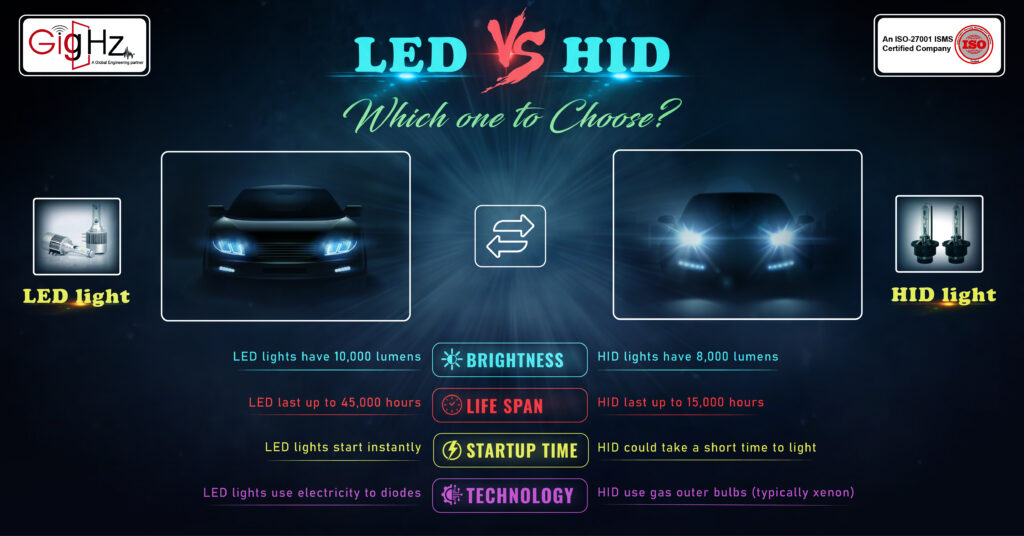
LED headlights vs. HID headlights is a new debate in headlight technology. More people are moving away from reflective halogen lights and installing LED and HID lights in their cars.
The two light types are similar in brightness and range but have important differences.
LED and HID headlights are the bulbs and equipment for cars that help drivers see at night.
HID headlights, or high-intensity discharge headlights, are headlights that use a combination of gas and metals to produce a bright blue and white LED light when the filament receives heat. HID headlights are premium headlights used for their brightness and ability to last a long time. This type of headlight is ideal for driving at night.
LED headlights are light-emitting diode headlights. They use semiconductors to transmit energy-emitting photons that create light. These headlights can get hot, so some require additional fans or heat sinks to control the temperature.
Some of the key features and differences of each include:
- Brightness: LED lights can have a brightness of 9,000-10,000 lumens while HID might have 8,000 lumens. Both, however, are brighter than traditional halogen lights.
- Technology: LED lights use electricity while HID uses gas (typically xenon).
- Energy use: Both have high energy use compared to halogen, but LEDs are slightly more energy-efficient.
- Life span: LED lights might last up to 45,000 hours while HIDs have a life span of around 15,000 hours.
- Bulb design: LED lights often have bulbs with diodes, locking tabs, and heat sinks. HID headlights can have outer bulbs, inner chambers, electrodes, and locking tabs.
- Price: Price can vary based on brand, but HID headlights are typically cheaper than LED headlights.
- Startup time: LED lights start instantly while the heating filament in HID could take a short time to light.
- Color: Both LED and HID lights can offer a range of colors.
- Distance: Both LED and HID lights have good range, usually up to 300 meters (about 985 feet).
Determine what you need from new headlights.
If you drive more during the day, consider the cheaper option of halogen or HID lights. You might also choose HID if you’re looking for a short-term solution.
Our pick for people who drive nightly would be LED for their brightness, quick starting, and life span.
Consider your location, too. If you live in a rural area with limited LED street lighting, convert to LED lights. If you live in a city, HID might be better. LED lamps were used for several demonstration projects for outdoor lighting and LED street lights.
Why LED Interior Lighting is so Cool?
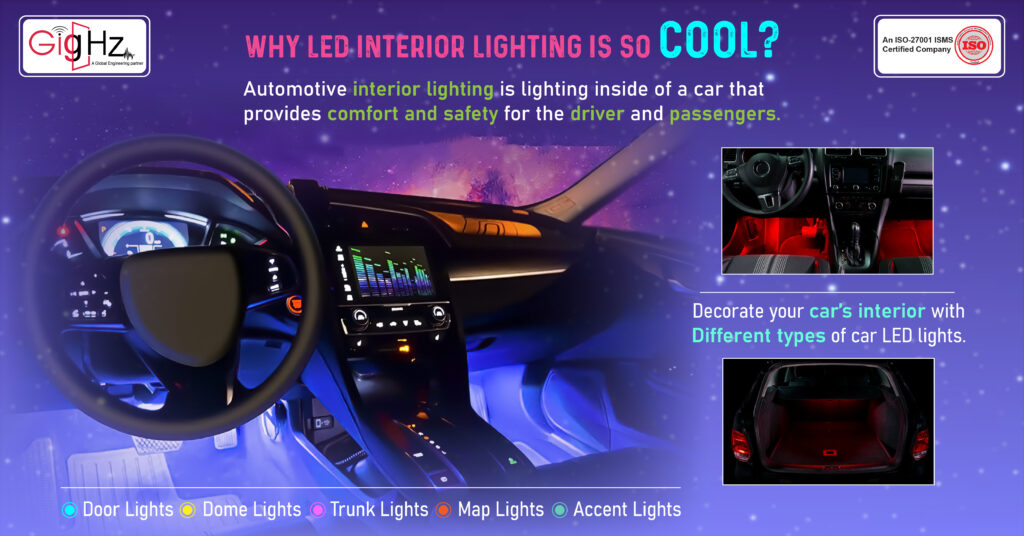
Car enthusiasts go to every extent to make their cars stand out. One popular way to do this is by introducing custom interior lights. These add color and vibe to your car.
Whether you need a cool blue glow or a multicolor impact, custom lights help you achieve an exceptional look.
Although they make your car’s interior look cool, they also illuminate the inside, making it harder to see outside. However, you can still stay cool and trendy while maintaining safety standards.
Custom interior car lights are usually LED in most cases, but bulb replacements are also a good alternative. There are many types of LED car lights, such as a strip, battery-operated, remote-operated, etc.
You might want to decorate your car’s interior with different types of car LED lights. Some custom interior car lights you can consider are door lights, dome lights, trunk lights, map lights, accent lights, etc.
While LED lighting fixtures are most commonly used around the house, under cabinets, or in commercial LED displays, there are many other creative and unique places where these handy little lights can find themselves at home!
One of the less common, but more impressive areas where our LEDs have been utilized is as accent lighting on vehicles.
Interior car lighting can provide a functional element in the ability to find things late at night.
If you’re an avid camper or frequent road trip adventurer, it can serve as a way to perform tasks a bit more easily than you might under the dim light of your car’s standard light fixtures.
Is Exterior LED Lighting Pleasant to the Eye?
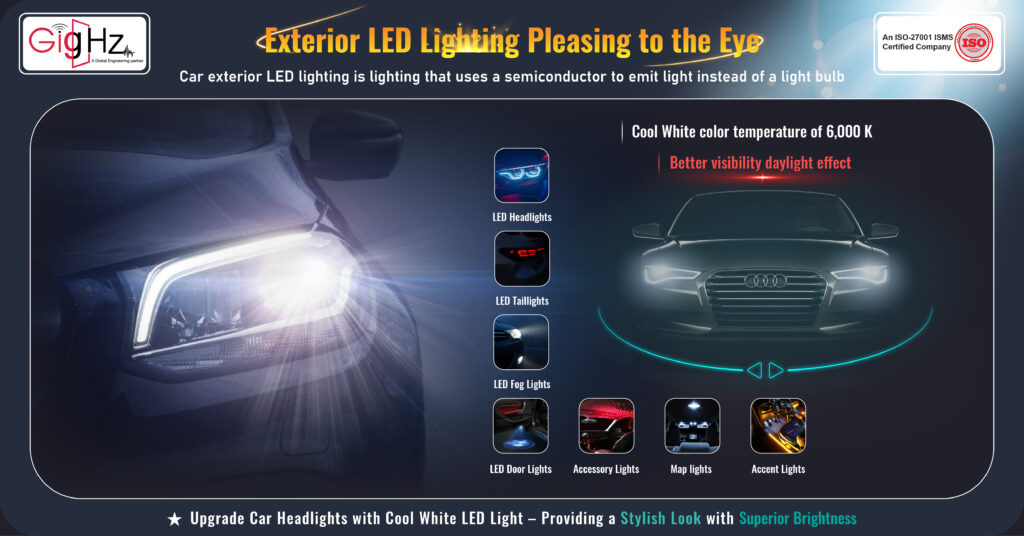
Car exterior LED lighting can include LED headlights, cornering lights, taillights, and turn signals.
Car exterior LED lighting is lighting that uses a semiconductor to emit light instead of a light bulb. The semiconductor generates light when a current passes through it.
There are several types of exterior LED lighting that you can put on your car.
LED headlights last longer than conventional lighting, produce a wider and longer beam of light and don’t produce a glare.
Many LED headlights are adaptive, meaning that they can adjust to curvy roads, corners, and traffic conditions, giving you more light when and where you need it.
While halogen headlights tend to only come in white or yellow, LED headlights are available in a variety of colors.
Like LED headlights, LED taillights produce more light while consuming less energy. They’re more visible to other drivers than conventional lights.
LED turn signal lights are more visible to other drivers when you engage your turn signal. They typically last for up to 50,000 hours.
LED fog lights deliver a sharper beam of light than conventional headlights. They’re available in a variety of shapes and sizes.
In addition to safety lights, you can add all sorts of LED accessory lights, such as underbody lights, light strips, and LED tubes. These come in a variety of colors and are an easy way to customize your vehicle.
Exterior car lighting, or under-lighting can make a bold visual statement, sure to make your ride stand out in a crowd.
But how exactly one installs an LED system is not as difficult as it sounds, since most car batteries output 12 volts, and this just happens to be the power requirement for most Inspired LED strip lights.
Door lights illuminate your doors at night time, so you can quickly find the door handle or window controls.
Dome lights enlighten the front and back of your vehicle when opening or shutting the doors. They’re a must-have addition for customized styling.
Trunk lights give your car’s trunk a unique, elegant look.
While map lights do not have much use, they can serve as additional lighting for the car to give it a distinctive look or read books or maps easily.
You can place accent lights anywhere in the vehicle to make it look extra unique and stylish.
What are the Advantages of LED Technology?
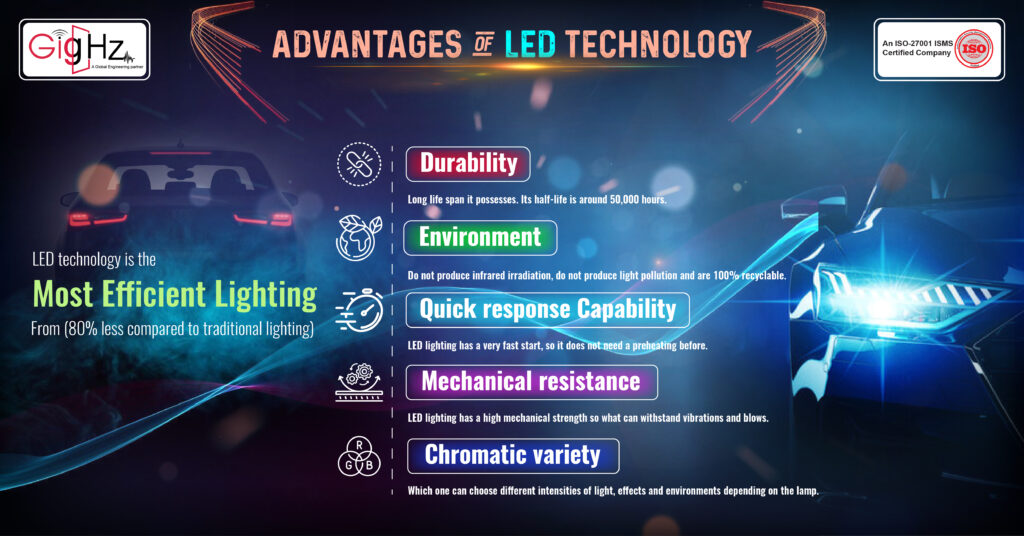
Exploring the benefits of LED lighting on the environment unveils its energy efficiency and long-lasting performance compared to traditional lighting sources. LED technology offers a numerous advantage and a few of them are sorted out below:
Today, energy saving is one of the basic pillars of any system, because in this way it contributes to making a transition towards greener and more efficient technologies.
LED technology is the most efficient lighting form, (80% less compared to traditional lighting). This means that about 80% of the electrical energy becomes light, consuming very little power and, therefore, emitting very little heat. Traditional incandescent bulbs only convert 20% of the energy into light, losing 80% in the form of heat.
LED lighting is characterized by the long life span it possesses. Its half-life is around 50,000 hours.
In addition, due to its great useful life, it makes maintenance costs less than for traditional technologies.
LED devices do not contain mercury, do not produce infrared irradiation, do not produce light pollution, and are 100% recyclable. It means that an LED light bulb can save material and produce 20 incandescent bulbs.
The use of LED lighting technology reduces the carbon footprint and CO2 and Sulphur emissions decrease in the atmosphere.
Quick response Capability
Unlike traditional technologies, LED lighting has a very fast start, so it does not need preheating before (such as fluorescent lighting).
Unlike traditional light bulbs and luminaires, LED lighting has a high mechanical strength that can withstand vibrations and blows, which makes the transport better support the blows without any damage.
One can choose different intensities of light, effects, and environments depending on the lamp or luminaire chosen.
In addition, there is the option of RGB (red, green, and blue, in its acronym in English) in which one can choose between the three shades.
The LED illumination has a CRI (chromatic reproduction index) greater than or equal to 80. This parameter indicates how much fidelity the LED illumination plays.

Conclusion
The lighting module incorporated with LED is energy efficient, faster, and provides a highly efficient response. Hence it is highly superior to conventional technologies and it is the reason behind its fastest growth.
An LED is a device quite useful to make a change toward a green and clean environment.
Here is the article describing all the aspects of LED lighting systems.
For more details, please don’t hesitate to reach us at
For more details, please don’t hesitate to reach us
For more details, please don’t hesitate to reach us


